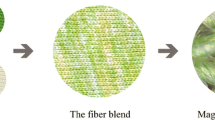Abstract
In order to apply the single-constant Kubelka–Munk (KM) model to color prediction of fiber blends, a novel correction method is proposed in the paper. The single-constant KM model is based on the assumption that the ratio of absorption coefficients to scattering coefficients (K/S) of a mixture is linear to mass proportion of its components. However, when it comes to the media of pre-colored fiber blends, the linear assumption always fails, resulting in inaccurate color prediction with large color difference. To solve this problem, a novel correction method was proposed, which improved the linearity of K/S in the way of decreasing the linear deviation. Pre-colored cotton fibers were used to prepare samples to examine the proposed correction method. The average color difference values ΔEcmc (2:1) and ΔE00 of the single-constant KM model with proposed correction method are 1.37 and 1.17 respectively, which are remarkably better than those of the Kubelka–Munk model without correction (~ 8.41 and 6.35) and the Kubelka–Munk model with Saunderson correction (~ 8.63 and 6.55). The results indicate that, for the media of pre-colored fiber blends, the proposed correction method greatly improves the color prediction accuracy.






Similar content being viewed by others
Data Availability
Not applicable.
References
X. Sun, Y. Xue, Y. Liu, G. Zhang, L. Liu, L. Wang, Text. Res. J. 93, 1358 (2023). https://doi.org/10.1177/00405175221132327
E.I. Stearns, F. Noechel, Am. Dyestuff Rep. 33, 177 (1944)
L.F.C. Friele, J. Text. Inst. Proc. 43(8), 604 (1952). https://doi.org/10.1080/19447015208664079
D.A. Burlone, Color. Res. Appl. 8, 114 (1983). https://doi.org/10.1002/col.5080080210
D.A. Burlone, Color. Res. Appl. 9, 213 (1984). https://doi.org/10.1002/col.5080090406
C. Hemingray, S. Westland, Color. Technol. 132, 297 (2016). https://doi.org/10.1111/cote.12220
B. Philips-Invernizzi, D. Dupont, A.-M. Jolly-Desodt, C. Cazé, Color. Res. Appl. 27, 100 (2002). https://doi.org/10.1002/col.10028
C.-A. Wei, X. Wan, J. Li, Dyes Pigm. 147, 544 (2017). https://doi.org/10.1016/j.dyepig.2017.08.012
X. Sun, Y. Xue, Q. Xu, J. Shen, Z. Xu, Text. Res. J. 93, 206 (2023). https://doi.org/10.1177/00405175221115887
B. Philips-Invernizzi, D. Dupont, C. Cazé, Color. Res. Appl. 27, 191 (2002). https://doi.org/10.1002/col.10048
L. Yang, J. Bai, R. Zhang, Y. Ding, F. Ji, Y. Ma, J. Yu, Y. Zhamg, Text. Res. J. 89, 4007 (2019). https://doi.org/10.1177/0040517519826892
R. Yang, K. Zhang, Z. Wang, Fibers Polym. 23, 1018 (2022). https://doi.org/10.1007/s12221-022-4230-0
P. Kubelka, F. Munk, Z. Tech, Phys. 12, 593 (1931)
P. Kubelka, J. Opt. Soc. Am. 38, 448 (1948). https://doi.org/10.1364/josa.38.000448
R.D. Duncan, Proc. Phys. Soc. 52, 390 (1940). https://doi.org/10.1088/0959-5309/52/3/310
H. Yang, S. Zhu, N. Pan, Text. Res. J. 80, 263 (2010). https://doi.org/10.1177/0040517508099914
J. Li, D. Xie, M. Li, S. Liu, C.-A. Wei, Front. Neurosci. 16, 945454 (2022). https://doi.org/10.3389/fnins.2022.945454
R. Furferi, L. Governi, Y. Volpe, By Workshops I (Springer, Genoa, 2015), pp.79–86
C.-A. Wei, X. Wan, J. Li, Cellulose 25, 2091 (2018). https://doi.org/10.1007/s10570-018-1669-7
R. Yang, Y. Xu, C. Xie, H. Wang, Dyes Pigm. 165, 151 (2019). https://doi.org/10.1016/j.dyepig.2019.02.008
R. Yang, C. He, B. Pan, Z. Wang, Text. Res. J. 92, 574 (2022). https://doi.org/10.1177/00405175211040871
G. Zhang, R. Pan, J. Zhou, L. Wang, W. Gao, Text. Res. J. 92, 2569 (2022). https://doi.org/10.1177/0040517521989788
X. Sun, Y. Xue, Y. Liu, L. Wang, L. Liu, Text. Res. J. 93, 2694 (2023). https://doi.org/10.1177/00405175221146290
J. Shen, X. Zhou, H. Ma, W. Chen, Text. Res. J. 87, 296 (2016). https://doi.org/10.1177/0040517516629145
Y. Zhou, Z. Chen, Y. Li, B. Ji, G. Wang, G. Liu, Nat. Sci. (2021). https://doi.org/10.19886/j.cnki.dhdz.2019.0373
J. Saunderson, J. Opt. Soc. Am. 32, 727 (1942). https://doi.org/10.1364/josa.32.000727
D.B. Judd, J. Res. Natl. Bur. Stand. 29, 329 (1942)
S. Mehrotra, SIAM J. Optimiz. 2(4), 575 (1992). https://doi.org/10.1137/0802028
J.R. Aspland, P. Shanbhag, AATCC Rev. 4(6), 26 (2004)
M.R. Luo, G. Cui, B. Rigg, Color. Res. Appl. 26, 340 (2001). https://doi.org/10.1002/col.1049
Acknowledgements
The authors would like to acknowledge Guangdong Esquel Textile Co. LTD for providing materials.
Funding
This work was supported by Natural Science Foundation of Henan (No. 232300421384); Henan Provincial Science and Technology Research Project (No. 232102210177; No. 212102310256; No. 222102210267; No. 202102210155); Startup Foundation for Doctors of Henan University of Animal Husbandry and Economy (No. 2020HNUAHEDF022).
Author information
Authors and Affiliations
Corresponding authors
Ethics declarations
Conflict of Interest
The authors declare no conflict of interest.
Ethical Approval and Consent to Participate
All authors declare informed consent.
Consent for Publication
All authors consent to the publication of this manuscript.
Rights and permissions
Springer Nature or its licensor (e.g. a society or other partner) holds exclusive rights to this article under a publishing agreement with the author(s) or other rightsholder(s); author self-archiving of the accepted manuscript version of this article is solely governed by the terms of such publishing agreement and applicable law.
About this article
Cite this article
Wei, C., Xie, D., Wan, X. et al. A Novel Correction Method of Kubelka–Munk Model for Color Prediction of Pre-colored Fiber Blends. Fibers Polym (2024). https://doi.org/10.1007/s12221-024-00559-8
Received:
Revised:
Accepted:
Published:
DOI: https://doi.org/10.1007/s12221-024-00559-8



